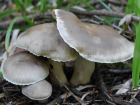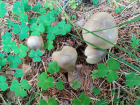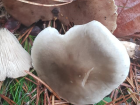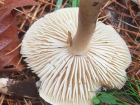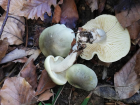Cap convex, becoming broadly convex or flat, often with a low, broad, rounded hump. The outline typically has irregular lobes or folds and splits. Cap occasionally is off-centre of the stem. Colour varies between greyish-green, yellowish-green, grey, blackish, copper coloured, or brownish. Gills white, becoming reddish spotted, emarginate, fairly distant. Stem more or less equal or slightly thicker below, sometimes tapered at base; often bent. Surface smooth to fibrillose or minutely scaly; white of weakly flushed with cap colours, brownish pink at the base. The stem has no ring. Spore print white.
Microscopic Features: Spores are ellipsoidal, smooth, measuring 5-7 x 3.5-4μm, and lack amyloid content.
Tricholoma saponaceum on the www.first-nature.com Web site.
Tricholoma saponaceum on the MushroomExpert.Com Web site.
Many mushrooms are poisonous, and some can be lethally toxic. Distinguishing between edible and poisonous mushrooms can be very challenging. Therefore, we strongly advise against consuming wild mushrooms. This website does not contain any information about the edibility or toxicity of mushrooms.
Although efforts have been made to ensure accuracy on this website, the information may contain errors and omissions. Therefore, all content provided is for educational and informational purposes only and should not be relied upon or used as a basis for consuming any plants or mushrooms.
External links are provided for reference only. We do not endorse or take responsibility for the content, advice, or products found on these sites or in any advertisements shown on this website.
